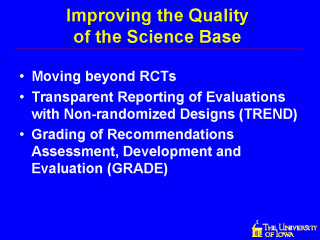| front |1 |2 |3 |4 |5 |6 |7 |8 |9 |10 |11 |12 |13 |14 |15 |16 |17 |18 |19 |20 |21 |22 |23 |24 |25 |26 |27 |28 |29 |30 |31 |32 |33 |34 |35 |36 |37 |38 |39 |40 |41 |review |
 |
Improving the
quality of the science base supporting EBPH can be addressed in many ways,
including the following: RCTs are well suited for demonstrating efficacy of a clinical intervention. They are less suitable for many public health interventions which have complex causal chains and which may be tested in communities that are quite variable. May have to standardize the intervention by function (diabetes education tailored to culture, education, etc.) rather than content. The TREND statement (Des Jarlais et al. Improving the reporting quality of nonrandomized evaluations of behavioral and public health interventions: the TREND statement. Am J Public Health 2004;94:361-366) provides a checklist and description of elements that should be present in papers reporting results from nonrandomized studies. It was developed along the lines of the Consolidated Standards of Reporting Trials (CONSORT) guidelines which were developed to improve the quality of RCTs. The GRADE system (GRADE Working Group. Grading quality of evidence and strength of recommendations. BMJ 2004;328:1490-1497) was developed in response to the variability in ranking systems used by various health-related organizations to assess the quality of evidence and the strength of recommendations. |